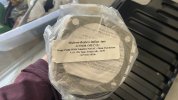ecohen2
True Classic
So I managed to remove the head and camshaft box and send it off to Midwest Bayless to have them fix and rebuild it. I now have a couple of weeks to do other stuff to the car. Unfortunately I have to pass state emissions, so I am back to the stock exhaust system and am limited to what else I can improve for performance. The car still has under 30k original miles, so most of it is in good condition..
On my list of things to do:
1. Passenger rear brake is dragging and appears to have been dragging for along time. Fix/replace/rebuild it, maybe rotors and pads
2. I have a new water pump in a box. My old one seems to work fine, should I do that while everything is apart and drained?
3. Going to replace the sensors that go into the head. Temperature etc..
4. Change out engine/transmission oil.
5. Replace some of the fuel lines.
I have a set of new pistons in a box, but I am not really sure I want to tackle that with everything else going on.
I also have a set of what appears to be rebuilt injectors that were at the bottom of a box, but are still in the wrappers. Again, I don't believe I have an issue with the existing ones, but everything is apart, do I do those?
Anything else a must do?
On my list of things to do:
1. Passenger rear brake is dragging and appears to have been dragging for along time. Fix/replace/rebuild it, maybe rotors and pads
2. I have a new water pump in a box. My old one seems to work fine, should I do that while everything is apart and drained?
3. Going to replace the sensors that go into the head. Temperature etc..
4. Change out engine/transmission oil.
5. Replace some of the fuel lines.
I have a set of new pistons in a box, but I am not really sure I want to tackle that with everything else going on.
I also have a set of what appears to be rebuilt injectors that were at the bottom of a box, but are still in the wrappers. Again, I don't believe I have an issue with the existing ones, but everything is apart, do I do those?
Anything else a must do?


